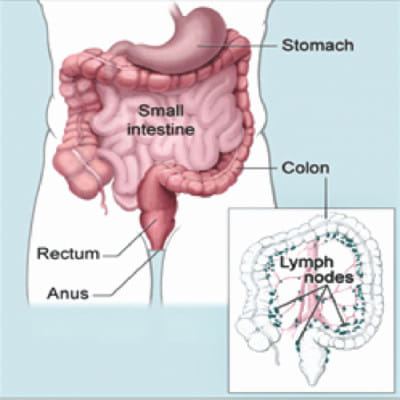Revolutionising colon cancer treatment

Colorectal cancer or colon cancer, which occurs in the colon or rectum, is the third most common cancer behind only lung and prostate cancers in men and lung and breast cancers in women, and the second leading cause of cancer death.
In layman terms, the colon is the large intestine or large bowel and the rectum is the passageway that connects the colon to the anus, thus cancer in such an important organ must be addressed and treated without delay.
Colon cancer, when discovered early, is highly treatable. Even if it spreads into any nearby lymph nodes, surgical treatment followed by chemotherapy is highly successful. In the most difficult cases — when the cancer has metastasized to the liver, lungs or other sites — treatment can prolong and affect one's quality of life. Most colon cancers develop first as colorectal polyps, which are abnormal growths inside the colon or rectum that may later become cancerous. Colon cancer affects men and women of all racial and ethnic groups and is most often found in people 50 years or older.
Colon cancer screening saves lives. Screening detects precancerous polyps and allows them to be removed before turning into cancer. Screening also helps find colon cancer at an early stage, when treatment often leads to a cure.
A new, less invasive keyhole surgery that promises for colorectal cancer patients who fit certain criteria is in the offing and trained doctors in Singapore have successfully done the surgery with the new technique. The tumour is removed without making a cut on the body through a natural opening, avoiding the need to make additional cuts. Now, in an even less invasive version of keyhole surgery, the diseased part can be removed through a natural opening, such as the rectum, sparing the patient that fifth cut. Surgeons say such natural orifice specimen extraction (Nose) is a step forward for colorectal surgery. Most surgeons remove the diseased part through the anus or vagina.
Cancer of the colon that is detected early is treated with surgery. If it is early-stage cancer that has not spread through a broken wall in the intestine, removing it gives many such patients an excellent chance of survival.
In conventional open surgery, a 20cm-long cut is made on the abdomen through which the surgeon removes the diseased colon.
In conventional laparoscopic surgery, also called keyhole surgery, the patient typically gets four minor incisions, between 5mm and 2mm each, through which special instruments are inserted for the surgeon to perform the operation. He also makes a fifth cut, about 4cm to 6cm long, through which he removes the diseased part of the colon.
Now trained surgeons are going for one less cut, "Colorectal surgery has been slower to follow other procedures in becoming minimally invasive, as it is more difficult to do so," said Dr Teoh Tiong Ann, a consultant colorectal surgeon at Mount Elizabeth Medical Centre.
"The area of operation is bigger than that in other procedures and there is always a problem of removing the cancerous specimen. This would usually be a segment of intestine, together with the fat, blood vessels and lymph nodes, and it has to be removed intact so it can be accurately analysed, especially in cancer cases," said Dr Teoh.
"Using standard laparoscopic instruments, the surgeon performs conventional laparoscopic surgery up to the point where he separates the diseased part of the colon from the rest of the gut," Dr Teoh said.
"It is then isolated and clamped so it does not contaminate the abdominal cavity. A pair of forceps is passed through the anus to grab the specimen, which is pulled out the same way. The rectal stump is then joined back to the colon or intestine. Patients are usually kept in a hospital until they have recovered their bowel function and to watch for complications, such as leakage at the sites that have been surgically re-joined," Dr Teoh added.
So far, from his own experience and that of his colleagues in Singapore and overseas, the risk of infection and complications from the Nose technique does not seem different from that of conventional laparoscopic surgery.
For these patients, the hospital stay was about a day or two shorter than for conventional laparoscopic colorectal surgery, which is about five days to a week.
Dr Teoh said recovery after nose surgery is generally faster than for conventional laparoscopic surgery as the only cuts are those made for the laparoscopic instruments. These tiny cuts are hardly noticeable after they heal.
"There is not much difference between the cost of nose surgery and that of conventional laparoscopic surgery," Dr Teoh said.
However, not everyone is a suitable candidate for this method of surgery. The best candidates are those with non-cancerous, left-sided lesions as these are close to the rectum and anus, as well as those who need to undergo total removal of their colons.
The tumour or part to be removed should not be in the lower rectum, as surgeons need to stitch the rectum to the remaining healthy colon after removal of the diseased part. "Too short a rectal stump will make it difficult to join", said Dr Teoh.
Non-cancerous growths or smaller tumours which have not penetrated the colon wall are suitable for removal through this surgical method. Those who need to have their entire colon removed are also suitable candidates.
Dr Teoh said, "Cancer patients are carefully selected for this procedure because of the concern or the fear of cancer cells from the diseased part getting into healthy tissue. But to be on the prudent side, we limit it to smaller tumours that are not seen to extend through the colon wall."
Dr Teoh Tiong Ann is a Senior Consultant Colorectal Surgeon at Mount Elizabeth Hospital, Singapore besides being a trained General Surgeon. Dr Teoh has subspecialty interest in Colorectal Surgery.
If you are seeking appointments for such specialised treatment, there are two patient assistance centres in Bangladesh, one in Chittagong and one in Dhaka to facilitate in availing treatments. E-mail [email protected] for further details.
– LS Desk

 For all latest news, follow The Daily Star's Google News channel.
For all latest news, follow The Daily Star's Google News channel. 



Comments